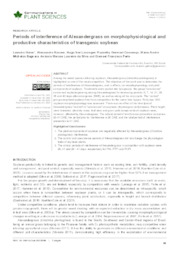Periods of interference of Alexandergrass on morphophysiological and productive characteristics of transgenic soybean.
Periods of interference of Alexandergrass on morphophysiological and productive characteristics of transgenic soybean.
Author(s): GALON, L.; KONZEN, A.; PIAZZETTA, H. VON L.; CONCENÇO, G.; ANDRÉ, M.; BAGNARA, M.; SILVA, A. M. L. DA; PERIN, G. F.
Summary: Among the weed species infesting soybean, Alexandergrass (Urochloa plantaginea) is highlighted as one of the most competitive. The objective of this work was to determine the periods of interference of Alexandergrass, and is effects, on morphophysiology and yield components of soybean. Treatments were pooled into two groups: the group ?convivence? comprised soybean growing among Alexandergrass for increasing periods: 0, 7, 14, 21, 28, 35 and 42 days after emergence (DAE), as well as along all the crop cycle. The ?control? group comprised soybean free from competition for the same time lapses. Forty-two DAE, soybean morphophysiology was assessed. There was no effect of the time lpse of Alexandergrass "control" or "convivence" on soybean physiological performance. Plant height, stem diameter, plant dry mass, leaf area and grain yield components of soybean were, however, affected by Alexandergrass. The critical period of interference prevention comprises 26-41 DAE; the period prior to interference is 26 DAE; and the total period of interference prevention is 41 DAE.
Publication year: 2022
Types of publication: Journal article
Keywords: Erva Daninha, Soja, Urochloa plantaginea
Observation
Some of Embrapa's publications are published as ePub files. To read them, use or download one of the following free software options to your computer or mobile device. Android: Google Play Books; IOS: iBooks; Windows and Linux: Calibre.
Access other publications
Access the Agricultural Research Database (BDPA) to consult Embrapa's full library collection and records.
Visit Embrapa Bookstore to purchase books and other publications sold by Embrapa.

